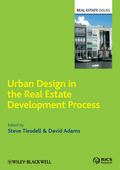
Urban design enables better places to be created for people and is thus seen in Urban Design in the Real Estate Development Process as a place-making activity, rather than the application of architectural aesthetics. Urban design policy can change the 'decision environment' of developers, financiers, designersand other actors in the real estate development process to make them take place-making more seriously. This book reports diverse international experience from Europe and North America on the role and significance of urban design in the real estate development process and explores how higher quality developmentand better places can be achieved through public policy. The book is focused on four types of policy tool or instrument that have been deployed to promote better urban design: those that seek to shape, regulate or provide stimulus toreal estate markets along with those aim to build capacity to achieve these. Urban design is therefore seen as a form of public policy that seeks to steer real estate development towards policy-shaped rather than market-led outcomes.The editors set the examples, case studies and evidence from international contributors within a substantive discussion of the impact of urban design policy tools and actions in specific development contexts. Contributions from leading urban design theorists and practitioners explore how: Masterplanning and infrastructure provision encourage high quality design Design codes reconcile developers' needs for certainty and flexibility Clear policy combined with firm regulation can transform developer behaviour Intelligent parcelisation can craft the character of successful new urban districts Powerful real estates interests can capture regulatory initiatives Stimulus instruments can encourage good design Development competitions need careful management Design review can foster developer commitment to design excellence Speculative housebuilders respond in varied ways to the brownfield design challenge Physical-financial modelscould help in assessing the benefits of design investment Urban design can add value to the benefit of developers and cities as a whole. INDICE: Preface. Acknowledgements. Contributors. 1 Real Estate Development, Urban Design and the Tools Approach to Public Policy (Steve Tiesdell and David Adams). Introduction. Real estate development. Opportunity space theory. The tools approach to public policy. Shaping instruments. Regulatory instruments. Stimulus instruments. Capacity-building instruments. Developers' decision environments. 2 Masterplanning and Infrastructure in New Communities in Europe (Nicholas Falk). Introduction. Differences between the UK and Europe. Challenges for sustainable development. European success stories. Joined-up planning inthe Randstad. Conclusion: lessons for the UK. 3 Design Coding: Mediating the Tyrannies of Practice (Matthew Carmona). Introduction. The three tyrannies. From development standards to design codes. The research findings. Conclusion. 4Proactive Engagement in Urban Design The Case of Chelmsford (Tony Hall). Introduction. Making the turnaround. The need for negotiation. Two examples. Reflections on the developers' response. Conclusion. 5 Plot Logic: Character-Building Through Creative Parcelisation (Tim Love and Christina Crawford). Introduction. Setting the rules. Parcelling and subdivision strategies. The primacy of the urban realm. The pitfalls of flexibility. Economic viability of low-scale,densely distributed buildings. Alternative models. Conclusion. 6 The Businessof Codes: Urban Design Regulation in an Entrepreneurial Society (Nicholas J. Marantz and Eran Ben-Joseph). Introduction. Zoning America. Developing America. Designing the American future. Conclusion. 7 Good Design in the Redevelopment of Brownfield Sites (Paul Syms and Andrew Clarke). Introduction. Redeveloping and reusing brownfield sites: the policy and regulatory context. Stimulus instruments in practice. Conclusion. 8 Competitions as a Component of Design-LedDevelopment (Place) Procurement (Steven Tolson). Introduction. The place promoter. The deliverer and competition participant. The (end) place matters most.The competition. Conclusion. 9 Design Review An Effective Means of Raising Design Quality? (John Punter). Introduction. Origins, emergence and critiques ofdesign review internationally. The typology of design review in England, Scotland and Wales. National design review: the genesis of CABEs procedures and processes. How design review can increase the opportunity space for design. The effectiveness of design review. Conclusions: design review and the quality of development control. 10 'Business as Usual?' Exploring the Design Response of UK Speculative Housebuilders to the Brownfield Development Challenge (David Adams and Sarah Payne). Introduction. The design debate around speculative housing development. The conventional approach to design and construction in speculative housebuilding. Responding to the challenge of brownfield development. Conclusion. 11 Physical-Financial Modelling as an Aid to Developers' Decision-Making (John Henneberry, Eckart Lange, Sarah Mo
- ISBN: 978-1-4051-9219-4
- Editorial: Wiley-Blackwell
- Encuadernacion: Cartoné
- Páginas: 344
- Fecha Publicación: 20/05/2011
- Nº Volúmenes: 1
- Idioma: Inglés
